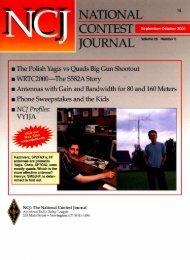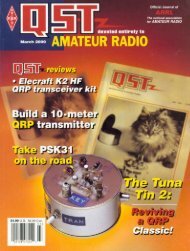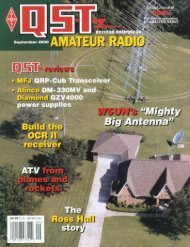WORKBENCHPROJECTS AND INFORMATION FOR THE ACTIVE AMATEURThe Doctor is INQGeorge, KD4KYM, asks, “I’m uncertain about how Ishould attach a 450-Ω ladder transmission line to myradio. I have SO-239 coax connectors on my Kenwood TS-520transceiver. Can I assume that it is simply a matter of solderingone side of the ladder line to the center conductor of aPL-259 and the other to the outer conductor? I want to use theladder line to feed a multiband 80-10 meter dipole antenna.”AYour TS-520 was designed for 50-Ω unbalanced coaxialcable. Your ladder line is 450-Ω balanced, so there is moreto deal with than just the physical differences. If you were goingto use the ladder line on just a couple of bands, you might be ableto get away with feeding the ladder line to a balun (a balanced-tounbalancefeed line transformer) with an appropriate impedanceratio (4:1, for instance), then using coax between the balun andyour radio. But since you’re aiming for broad, multiband coverage,I’d recommend an antenna tuner.Most antenna tuners are designed with built-in baluns to handlethe impedance transformation. There are usually three posts inthe back of a tuner—two for ladder-line and one for random wireantennas. There may be a jumper between the random wire postand one of the ladder-line posts. Make sure the jumper is removed—itis only used for a single random-length wire.If your tuner does not have provisions for ladder-line, you canconnect it as you say, by soldering the ladder line to a PL-259. Itmay work, but not as well as using a balun. Of course, you couldalways install an external balun in the line between the ladderlineand the antenna tuner (see Figure 1), although we don’t recommendthat you run high power with such a setup.Figure 1—If you own an antenna tuner that does not include an internal balun, you can use an external balun. Just keep thecoaxial connection between the balun and the tuner as short as possible.QGary, KD4SRX, asks, “I read the product reviews in<strong>QST</strong>, talk with other hams and radio dealers, and I’m stillvery much confused about handhelds (H-Ts). I’m not sure whatmodel would suit my needs. To be more specific, I like workingvarious ham events, as well as taking my handheld on Amtraktrain trips along the Northeast Corridor. With all these variousmodels to choose from, which features are the most important?”AI’d suggest that you look for an H-T with a large battery pack(you may have to purchase this separately). Choose a packthat has enough capacity to last through a daylong hamfest orpublic-service event. I would suggest looking for one that has atleast 600-m/Ah capacity.Also, although 5W output is not a must, having at least 2 1 /2 to3 W helps when trying to work someone (via simplex) who is onthe other side of the hamfest grounds (for an outdoor hamfest).Higher output power will also be helpful when attempting to workstations from a moving train. Most modern handhelds will receivethe 160-161 MHz Amtrak frequencies in the Northeast Corridor,but check the specs to be sure.Concerning battery life, consult the <strong>QST</strong> Product Reviews andrefer to the power requirements section. This will tell you themaximum receive and transmit current drawn for each handheldunder consideration.Ease of programming is another thing to consider, but there isa mitigating factor. If your H-T has a lot of features that you won’tuse, it doesn’t matter if you can’t remember (or figure out) howto program them. I prefer H-Ts with the most frequently used46 <strong>May</strong> <strong>2000</strong>functions marked on the buttons (like switching between memoryand VFO mode, setting PL tones, etc.). Failing that, you can makeup a small (2-inch square) “cheat sheet” with the most importantfunctions written on it.Unless you plan on carrying the manual with you everywhere,direct keypad frequency entry is practically a must. Also convenientis automatic repeater offset, although that is more of a luxurythan a necessity (if “-” doesn’t bring up the repeater, just switchto “+” —assuming you don’t need to consult the manual to rememberhow).Don’t forget audio quality. You want to be able to understandwhat is being said, even when you are in a noisy area. If a particularradio’s audio is poor, the Product Review will mention it.Most H-Ts are pretty rugged. You don’t have to treat them asyou would an expensive camera, but reasonable care is required(a 3-foot drop onto a hard surface is survivable if it only happensonce in a great while).QBill, N3SNU, asks, “The display malfunction on my ADI-146 is definitely temperature-dependent. During summer,and to a lesser extent during spring and fall, all thesegments of the LCD display activate so it is impossible to tellwhat frequency the radio is on, or any other displayed parameters.The radio apparently still works fine. Transmitting,especially on high power, causes heat to build up faster and thedisplay to go haywire sooner, but in hot weather just havingthe radio on receive during a long drive will eventually bring
on the problem. This is a mobile radio, installed in the familycar, and taking it out whenever the car is parked is not apractical solution. If I had to resort to that I might as well goback to carrying a handheld and plugging it into an externalantenna. Any troubleshooting suggestions?”problem crops up in many LCDs in conditions of ex-AThis treme heat. Typical problem conditions include the obvious(when the car has been sitting in the sun on a 90° day with thewindows closed) and the not so obvious (on a moderately warmday with the radio mounted on top of the dash in direct sunlight,or mounted in the dash without ventilation space around it). Theideal mounting position is under the dash where the rig would getsome shade, but adding a small 12V fan helps in installations thatare less than ideal.If the display is failing under more normal conditions, then theLCD itself or the display driver circuit is very likely defective. Ifthe radio was purchased recently, I would suggest asking thedealer for an exchange. If the dealer can no longer exchange it,then having ADI repair it may be your only option. This is not aproblem that can be easily tackled on the typical workbench.QKaehu, WH6WW, asks, “I want to use one coax run formy VHF and UHF station, but I also want to have avertical and a beam. I think a coax relay would provide thesolution. Is this something I could fabricate from RadioShackcomponents or should I buy one commercially?”AWhen switching multiple feed lines, the impedance of theswitching network is a prime consideration. The impedanceof a feed line is a function of the conductor surface areas and thespacing between them. When you insert a standard type of relayin the line, you will have a point with a different impedance, witha resultant change in SWR. At HF, the SWR difference is notlikely to be significant, but at VHF and UHF this is not the case.This doesn’t make homebrewing impossible, but it does add amajor complicating factor.Remote coax relays are available for VHF and UHF, but theyare costly (it may be cheaper to run multiple lengths of coax). Ifthe cost is not a consideration, you can purchase a remote coaxrelay from these folks:Electronic Switch Co8491 Hospital DriveSuite 328Douglasville, GA 30134tel: 770-920-1024k4mzw@akorn.netQDon, W9DEW, asks, “I have owned an ICOM IC-720Aand a Kenwood TS-450S for several years and have neverreally understood when to use the attenuator as opposed tosimply turning the RF Gain control down. I think I understandthe difference, but the result seems to be the same. Isthere any real difference?”AIn a practical sense, there is no difference. However, at highlevels of attenuation the RF gain control may be hard to set, sothe fixed attenuator is easier to use. Under some circumstances youmight even need both. When band noise and signals are both overS 9 with the RF gain up all the way, the attenuator will bring themdown to where the RF gain can be used for “fine tuning” the level.QSteve, N8UBR, asks, “I put up a 10-meter quarter-wavelengthground plane antenna on my property in mysubdivision. When doing an RF safety evaluation for thissystem, is the distance measured from the main vertical radiatoror the ground plane radials? (I plan to use 100 W.) Theradials are currently above the ground, but will be buried inthe spring when the ground thaws.”AIf I were doing your evaluation, I would consider radials thatwere within a few inches of the ground to be grounded andwould do my calculations from the main antenna itself. If I had aground-plane antenna with elevated radials, I would, to be conservative,consider them as an active part of the antenna system. Thesimple evaluation methods, such as the one found on the Universityof Texas Web page (see “The Doctor is IN,” February <strong>2000</strong>), worksvery well for ground-mounted verticals. You can assume about 1dBi of antenna gain and do use the ground-reflection factor.Start with your 100 W output and adjust it for the operatingmode and typical duty cycles.100 W CW = 40 W100 W SSB = 20 to 40 W, depending on speech processing,use 30 W for average speech processing100 W FM, RTTY, other digital = 100 WThen, adjust it by the amount of time you might be transmittingcontinuously during the averaging time of 6 minutes for controlledexposure or 30 minutes of uncontrolled exposure. For“conversational” operating, you can use 100% for controlledexposure and about 67% for uncontrolled. If you wish, you canalso make further adjustments for feed-line loss, but I will referyou to RF Exposure and You for more info on that.For a 1-dBi-gain antenna on 28 MHz, this typically works out to:Mode Controlled Distance (feet) Uncontrolled Distance (feet)SSB 2.7 4.9CW 3.1 5.8FM 4.9 9.0This all assumes 100 W, 1 dBi, 28 MHz, 10 minutes on, 10minutes off, 10 minutes on and moderate speech processing forSSB. If you and your family are greater than 4.9 feet from theantenna and your neighbors are greater than 9 feet from theantenna, you can run 100W continuous duty (carrier) for anindefinite period.The required distances are from your antenna to any point wherepeople could actually be exposed. Most hams choose to controlexposure in their backyard by instructing their families not tolinger closer than the controlled distance to their antennas whenthey are on the air. You should also take some steps to ensure thatno one can accidentally contact your antenna. Hams generally usetheir property line as the criterion for the uncontrolled distancebecause they have no way of knowing whether their neighbor mightbe spending time near the property line. With the above assumptions,if you operate SSB on 10 meters with 100 W and your antennais located 4.9 feet from the property line, you are in compliance.QJohn, KF6EOJ, asks, “I just recently completed a modificationof a RadioShack FM antenna for 2 meter use, butI am a little confused about the issue of vertical vs. horizontalpolarization. Two members of my local club say that for FMuse I should use the antenna vertically polarized, which meansmodifying the antenna mounting holes, which I have alreadydone. Is this true? I only have a FM H-T and I intend on usingthe antenna to increase my range.”AWhen amateur 2-meter FM repeaters came along in the 70sthey were used primarily for mobile communication. Horizontalmobile antennas proved cumbersome (remember theHalo?) and so vertical whips were the favored. Repeaters followedsuit, using vertically polarized antennas as well. Thepenalty for a polarization mismatch (using horizontal polarizationwhen the other station is using vertical, or vice versa) is asubstantial signal loss.So, the established custom among FM operators is to use verticallypolarized antennas. If you want to communicate with otherFM stations, choose vertical polarization.On the other hand, you should know that 2-meter SSB and CWoperators use horizontal polarization—if you ever decide to give2-meter DXing a try.Do you have a question or a problem? Ask the doctor! Send yourquestions (no telephone calls, please) to: “The Doctor,” ARRL, 225Main St, Newington, CT 06111; doctor@arrl.org; http://www.arrl.org/tis/.<strong>May</strong> <strong>2000</strong> 47
- Page 6 and 7: May 2000 Volume 84 Number 5David S
- Page 11 and 12: THE AMERICAN RADIORELAY LEAGUE INC
- Page 14: Get to Know Your Section ManagerThe
- Page 18: The ARRL and the FCC’s Private Wi
- Page 22 and 23: The postman always keys twice.Accor
- Page 26 and 27: CORRESPONDENCEYour opinions count!
- Page 30 and 31: By Ian Poole, G3YWXOperating in the
- Page 32 and 33: By Roger Sullivan, WA0ETE, and Hugh
- Page 34 and 35: By Jim Graver, KB8PSO2000Dayton Ham
- Page 36 and 37: Figure 1A—Schematic of the interf
- Page 38 and 39: All input/output connections are ma
- Page 40 and 41: Figure 4—Hanger loopconstruction.
- Page 42 and 43: Figure 2—A GOES-8 picture capture
- Page 44 and 45: By Steve Ford, WB8IMYPSK31 2000In e
- Page 46 and 47: the software, PSK31 tuning required
- Page 50 and 51: By Martin A. Minow, K6MAMPractice M
- Page 52 and 53: the download to a suitable location
- Page 54 and 55: 52 May 2000SHORT TAKESHeil Sound Go
- Page 56 and 57: By Zack Lau, W1VTA No-Tune 2-Meter
- Page 58 and 59: HINTS & KINKSA FOLD-DOWN MOBILE-ANT
- Page 60 and 61: By James Kates, N9GBBConfessions of
- Page 62 and 63: PRODUCT REVIEWKenwood TM-D700A Dual
- Page 64 and 65: is accomplished by using OK, BACK a
- Page 66 and 67: other radio operation. The chatter
- Page 68 and 69: operation because there’s so litt
- Page 70 and 71: consideration in the WT Docket 98-1
- Page 72 and 73: News in Brief:• League members no
- Page 74 and 75: communications tests in celebration
- Page 76 and 77: I’ve done this tour several years
- Page 78 and 79: The Crystal Symphony at anchor off
- Page 80 and 81: Table 1Claimed North American Dista
- Page 82 and 83: Okay in My LogBy Vic Curtis,WA3YUVP
- Page 84 and 85: their 432 MHz triumph of the previo
- Page 86 and 87: 2000 ARRL Field DayRulesBy Dan Hend
- Page 88 and 89: Collecting Vintage QSLsOLD RADIOAn
- Page 90 and 91: DIGITAL DIMENSIONAPRS Digipeater in
- Page 92 and 93: AT THE FOUNDATIONWhy We Fund Museum
- Page 94 and 95: It is with deep regret that we reco
- Page 96 and 97: COMING CONVENTIONSARRL NATIONAL CON
- Page 98 and 99:
checking; handicapped accessible; f
- Page 106:
of the West Allis ARC and served as
- Page 110:
introduced that could of had a bear
- Page 114:
211/109; NJN/L 29/203/103; CJTN 29/
- Page 118:
W1PEX 1048, WA1JVV 143, N1NH 105, W
- Page 124:
an activity we enjoy so much can be
- Page 128:
126He is President of the Amateur R
- Page 132:
is Walt Bacon, N6SMT, who is curren
- Page 150:
Ham Adsl) Advertising must pertain
- Page 154:
BAHAMAS RENTAL: Abaco villa w/stati
- Page 164:
“EVERYTHING FOR THE MORSE ENTHUSI
- Page 168:
TUBES WANTED: Highest prices paid o
















